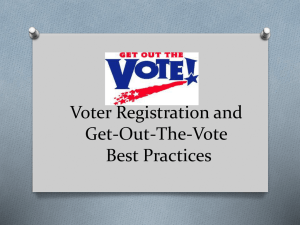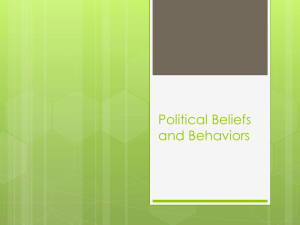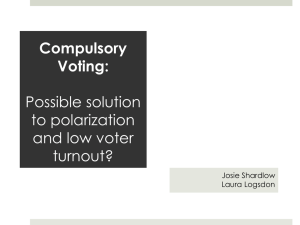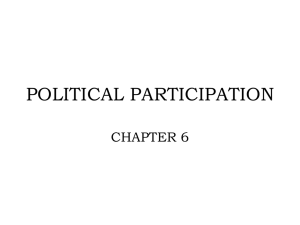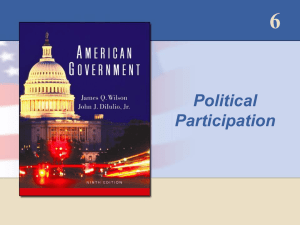Political Satisfaction as a Cause of Voter Apathy
advertisement
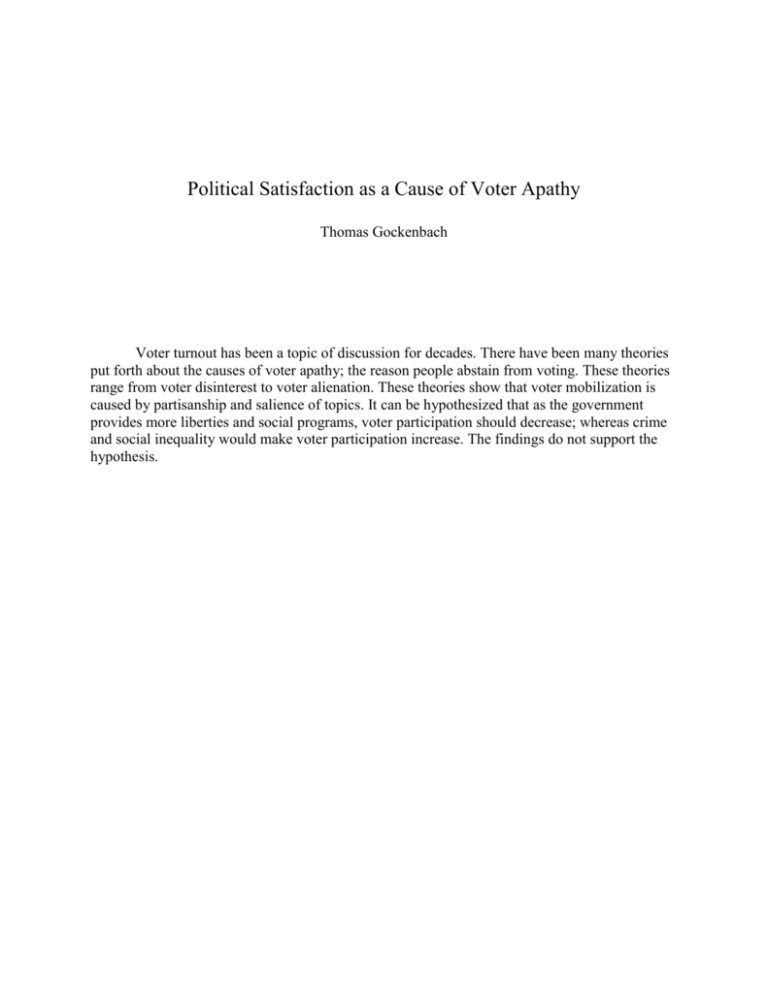
Political Satisfaction as a Cause of Voter Apathy Thomas Gockenbach Voter turnout has been a topic of discussion for decades. There have been many theories put forth about the causes of voter apathy; the reason people abstain from voting. These theories range from voter disinterest to voter alienation. These theories show that voter mobilization is caused by partisanship and salience of topics. It can be hypothesized that as the government provides more liberties and social programs, voter participation should decrease; whereas crime and social inequality would make voter participation increase. The findings do not support the hypothesis. In a study done by Kyle Dodson (2010), on the effect of party polarization has had a positive impact on voter turnout, Dodson argues that party polarization creates an environment where parties offer “increasingly dissimilar policy alternatives” so that both sides are “less satisfactory to citizens. This divergence [in policy] makes accomplishing preferred policy proposals more important and citizen involvement more likely” (Dodson 2010, 445). His study found that as political parties become further polarized, and as citizens are reminded of dramatically different and competing alternatives, that they will be more likely to vote. To Dodson, this polarization creates political involvement by creating a sense of importance for the political environment. Politics are increasingly becoming more extreme dichotomies. These extremes are also becoming more controversial; the increase in number of controversial issues increases the likelihood that an individual will be affected by an issue and thus be compelled to vote. This relates to voter apathy, because the study shows that party polarization has an effect on eliminating voter apathy, and has been in use for the past twenty years. Politicians have been reminding people of the “either-or” political atmosphere, and mobilizing votes. However, despite their efforts, political apathy continues to persist. In a related study done by Ryan Claassen and Benjamin Highton (2009), they discuss the relationship between political party elites and political masses. They define two groups of masses politically aware, and politically unaware. They identify that most of the mass public falls in the “unaware” category; though, there is a sizable portion who are informed (Claassen and Highton 2009, 539). The hypothesis they provide claims that as party elites become more polarized, the informed masses also become more polarized. Looking at Claassen and Highton, an insight into voter apathy can be found; that political unawareness contributes to voter apathy, despite increased party polarization. Party polarization is not sufficient to combat voter apathy. In a study published in 2006, James Adams, Jay Dow, and Samuel Merrill identify two major causes for voter abstention; alienation from candidates and indifference toward candidates. They found that around 45-50% of voters abstain from alienation or indifference (Adam, Dow, Merrill 2006, 75) and more specifically that around 14% abstain purely from indifference (2006, 74). This study identifies two major causes of voter apathy and allows for the individual study of both alienation and indifference and their effects on voter apathy. The main concern in this study is indifference toward candidates and policies. James Fowler and Cindy Kam published a study in 2006 where they analyzed patience on voter turnout. They state that voter turnout is related to the cost of going to the polls and the benefits of outcome of the election (Fowler and Kam 2006, 114). Folwer and Kam claim that there is a delay in voter gratification; the voters pay the cost of going to the polls, but will not receive the benefits of voting for months or years (2006, 115); this is delayed gratification (2006, 116). They found that the more patient a person is, the more likely they are to vote (2006, 120); in other words, a lack of patience would have a negative effect on voter turnout. This is another possible explanation for voter turnout. Many people, like uninformed voters may not see the importance of voting, or the impact it can have, so the process to go vote may not seem to be a worthwhile endeavor; this is compounded for the number of people who have not even registered to vote. Also, depending on weather, schedules, or emergencies, voting may be difficult to accomplish. This article shows that other concerns may very well take precedence over voting. In an interesting article, “Better to Shop than to Vote?” form 2001, Noreena Hertz, identifies a trigger of voter apathy: voters’ perceived ineffectiveness in policy making. There is an alienation of the voter by policy makers and these voters are instead turning to businesses. She suggests that businesses are more responsive to public outcry from their patrons than elected officials and that businesses have taken the initiative while policy makers argue (Hertz 2001, 90). This is interesting because it suggests that voter apathy is not an abstention of voting. Rather, voters are seeking different political outlets. However, despite the fact that people may turn to businesses for political action, it does not explain the long history of voter apathy, or the remaining abstaining voters whom do not turn to business for political actions. Morris Rosenberg, in 1954, published a study where he interviewed several individuals about their voting behavior, to try and find some determinants of political apathy. One such cause was the futility of voting, where voters feel that there is no point to voting because their vote will not affect the outcome of the election (Rosenberg 1954, 354). Several interviewees felt that the elected officials did not care about the voters (Rosenberg 1954, 357). This relates to why voters feel alienated by their government. If voters felt useful in the election process, they may vote more. Moreover, if voters felt appreciated by their elected officials, they would vote more. However, it is uncertain that if officials did what their constituents wanted, and voters felt like they made a difference, that those voters would continue to vote. They would have no need to vote if the government did what they wanted; also, if they felt that there vote mattered, they may abstain from voting until an issue was important enough to vote on. These studies have set a foundation for determining voter apathy. This analysis seeks to determine the specific causes of voter indifference. It is clear that salience of issues brings forth more voters; that is, the more the issues affect voters, the more voters will turnout. Claassen and Highton pointed out that the more polarized political elites become, the more dichotomous issues become (Claassen and Highton 2009, 543); thus the extremes on both side will provide a haven for voters who simply oppose the other pole. However, their study only showed that polarization affects the informed masses, not the uninformed. One thing can be interpreted by these studies; that voters mobilize because of a perceived need to make their voices heard. One position not looked at by researchers is the possibility that voter apathy persists because voters perceive that the government is doing well, and therefore there is no need to vote. If general welfare and happiness of the citizens is increased, then turnout should decrease. It can be theorized that adequate governmental support for liberal, social programs, which help people, would decrease voter turnout because the government already provides enough. On the other end, as crime increases voter turnout should increase as voters perceive more of a need for governmental action. I analyze eight variables, which should either increase or decrease voter turnout. The analysis focuses on the state as the unit of analysis, throughout five federal elections from 2000 to 2008. The first variable is unemployment. As unemployment rises, voter turnout should also rise, as voters seek help and accountability from the government and elected officials. Unemployment is represented in percent of the population. Second, we look at violent crimes. According to the hypothesis, as violent crimes increase, voter turnout should also increase due to public concern for crime. Violent crimes are coded for every one-hundred thousandth of the population. For example, Alabama in the year 2000 had four-hundred eighty-six violent crimes for every one-hundred thousand people (Disaster Center 2010). The third variable is property crimes. Much like violent crimes, it is expected for property crimes and voter turnout to be positively correlated. Also, like violent crimes, property crimes are for every one-hundred thousand state inhabitances. Fourth, there is poverty. Much like unemployment, as poverty increases, there should also be an increase in voter turnout as a greater portion of the population seeks government aid. Poverty is represented by percent of population which lives below federal poverty guidelines. The fifth variable is government expenditure on the Child Health Insurance Program. Though increased enrolment and spending on CHIPs is likely related to the poverty level, or unemployment, it still can be argued that as a beneficial governmental program, the more money spent on it, and thusly on the children, would signify that the government is taking care of the people, and decreases voter turnout. Expenditures are represented in millions of dollars. Sixth, we look at recipients of social security. As recipients of social security, goes up, and therefore, the more people who benefit from government aid, those people should be less inclined to vote, and thus decrease voter turnout. This is in percent of the population who receive social security benefits. The final two variables are both represented as dichotomous. Whether or not a state allows medicinal marijuana, and whether or not the state recognizes same sex marriage. Because these are polarized issues, we would expect voter turnout to increase before the legalization, and decrease after. Legal is coded as “1” and illegal or not recognized is coded as “0”. There are a few omitted variables in the analysis. CHIPs variable is missing two variables, and there was not percent of population receiving Social security for the year 2000. Moreover, there was a lack of data for several other variables, so they were not included in the study; for example, there was not enough data on some other social programs. Coefficientsa Standardized Unstandardized Coefficients Model 1 B (Constant) Std. Error 54.247 8.140 UnemploymentPercent 2.404 .757 ViolentCrimes -.009 Property Crimes Coefficients Beta t Sig. 6.664 .000 .230 3.177 .002 .005 -.141 -1.732 .085 -.003 .001 -.233 -2.673 .008 PovertyPercent -.708 .324 -.185 -2.188 .030 CHIPsSpend -.013 .006 -.177 -2.243 .026 .394 .402 .083 .981 .328 MedicalMarijuana 2.760 2.030 .095 1.360 .176 SameSexMarriage 2.622 4.024 .046 .652 .515 PercentRecievingSS a. Dependent Variable: PercentVote Descriptive Statistics N Minimum Maximum Mean Std. Deviation PercentVote 250 24.57 74.27 49.1232 11.15340 UnemploymentPercent 250 2.30 8.30 4.7952 1.18534 ViolentCrimes 250 66.30 822.70 406.8464 180.40294 Property Crimes 250 1619.60 5849.80 3380.7500 814.52725 PovertyPercent 250 5.30 21.61 12.4540 3.12171 CHIPsSpend 248 .42 1259.30 90.5090 145.18894 PercentRecievingSS 200 9.10 23.70 16.7345 2.47783 MedicalMarijuana 250 0 1 .18 .385 SameSexMarriage 250 0 1 .04 .187 Valid N (listwise) 199 The results of the regression are slightly mixed. The first variable held true to the analysis; as unemployment increased, so too did voter turnout. For every percent unemployment goes up, voter turnout increases about two and a half percent. This result was ninety-nine percent confident. The second and third variables, violent and property crimes had a negative effect on voter turnout, the opposite as hypothesized. Violent crimes did not reach ninety-five percent confidence; whereas property crimes reached ninety-nine percent confidence. Despite this, neither effect was ample enough to warrant any real substantive significance. The fourth variable, poverty, also decreased voter turnout. For every percent increase in the population of a state that lives below the poverty line, voter turnout decreases by .7 percent, and has ninety-seven percent confidence. This is the exact opposite of what was expected, as people should turn to their government for help out of poverty, or a solution to poverty. Spending on the Child Health Insurance Program, on the other hand, like unemployment, does follow the hypothesis. As spending for CHIPs increases, voter turnout decreases. However, like violent and property crimes the effect is drastically minimal, despite reaching ninety-five percent confidence. The percent of the population who receives Social Security benefits has an opposite effect than was predicted in the hypothesis. As the recipient population of Social security increases, so too does voter turnout; however this did not reach statistical significance. Medicinal marijuana and same sex marriages also had an opposite effect than as predicted. States which allowed either, had considerably higher voter turnout; however, both variables were far from reaching statistical significance. When interpreting these results it is interesting to note some of the instances where the variables proved to have an opposite effect than as predicted. Poverty, though should lead to increased voter turnout proved otherwise. This can be explained, in part by Claassen and Highton who identify an uninformed mass. Part of this lack of information could be explained by lack of access to information; which may be limited while suffering economically. Moreover, people who live in poverty may not have an ability to travel to vote, or the time to spare. Also, there is the variable of percent of the population which receives Social Security benefits. As the number of recipients increases, voter turnout should decrease; instead the regression suggests the opposite. This could be explained by Social Security being a controversial issue which gets spoken about in almost every election. Though citizens should be satisfied with the Social Security provided, there is a constant threat of losing that aid, which then mobilizes the voters to protect their benefits. This can be used to explain medical marijuana and same sex marriages, despite their lack of significance. Voter apathy can be explained by a number of different factors. Though some variables have held with the hypothesis, there is little evidence to show that voter apathy is caused by a sense of political satisfaction. This does not render this study useless. This study does not look all social programs; nor does it identify whether social programs, which would help citizens and decrease voter turnout, are being threatened. Political satisfaction could still be a factor in voter apathy, but threats to that satisfaction could be a mobilizing force for voting. Bibliography Fowler, James H. and Cindy D. Kam. 2006. “Patience as a Political Virtue: Delayed Gratification and Turnout.” Political Behavior, Vol. 28, No. 2 (June): 113-128. Hertz, Noreena. 2001. “Better to Shop than to Vote?” Buisness Ethics: A European Review. Vol. 10. No. 3 (July): 190-193. Dodson, Kyle. 2010. “The Return of the American Voter? Party Polarization and Voting Behavior, 1988 to 2004.” Sociological Perspectives. Vol. 53. No. 3 (Fall): 443-449. Merrifield, John. 1993. “The Institutional and Political Factors that Influence Voter Turnout.” Public Choice. Vol. 77. No. 3 (November): 657-667. Dean, Dwight G. 1960. “Alienation and Political Apathy” Social Forces. Vol. 38. No. 3 (March):185-189. Adams, James, Jay Dow and Samuel Merrill III. 2006. “The Political Consequences of Alienation-Based and Indifference-Based Voter Abstention: Applications to Presidential Elections.” Political Behavior. Vol. 28. No. 1 (March): 65-86. Rosenberg, Morris. 1954. “Some Determinants of Political Apathy.” The Public Opinion Quarterly. Vol. 18. No. 4 (Winter): 349-366. Claassen, Ryan L. and Benjamin Highton. 2009. “Polarization among Party Elites and the Significance of Political Awarness in the Mass Public.” Political Research Quarterly. Vol. 62. No. 3 (September): 538-551. U.S. Census Bureau. “2012 Statistical Abstract.” http://www.census.gov/compendia/statab/cats/health_nutrition.html. (December 10, 2011). NORML. “State Info.” http://norml.org/states. (December 11, 2011). Peterson, Kavan. “50-state rundown on gay marriage laws.” http://www.stateline.org/live/ViewPage.action?siteNodeId=136&languageId=1&contentId=1557 6. (December 11, 2011). Tills, Brad. 2009. “States that have Decriminalized Marijuana.” Drug Policy for the 21st Century Conference. (February).



